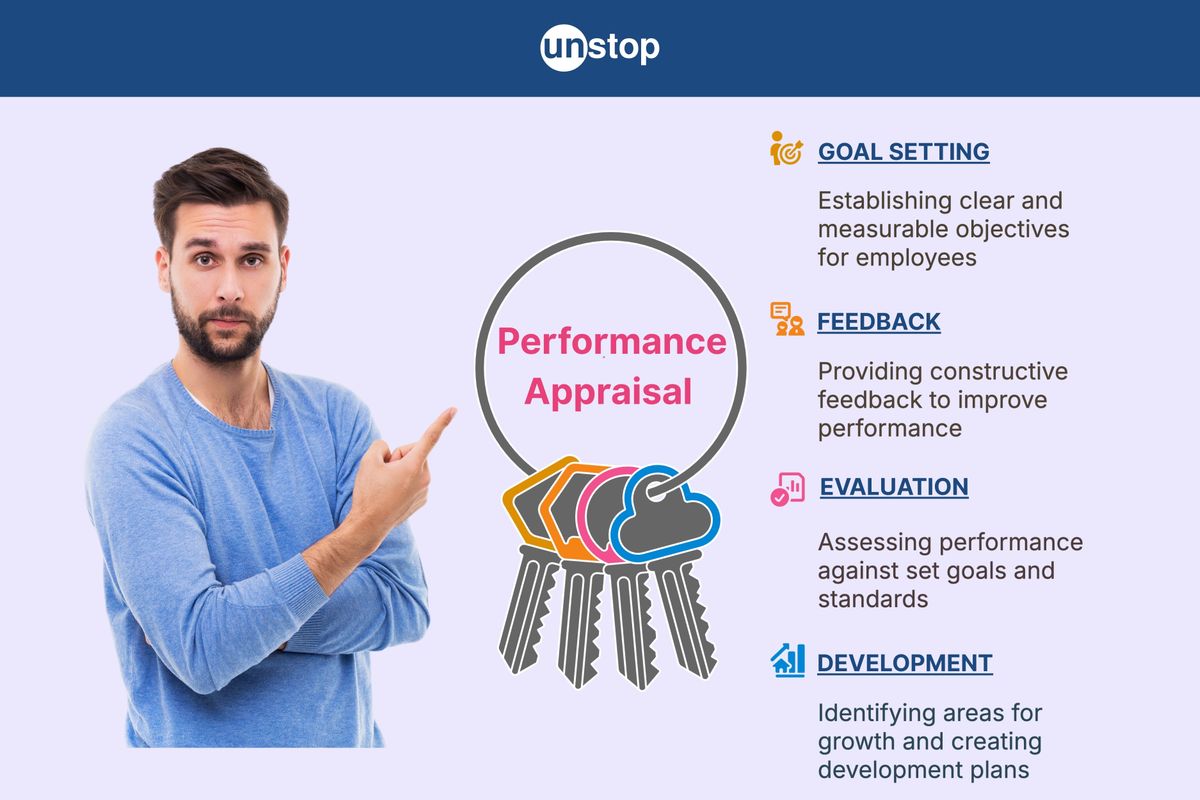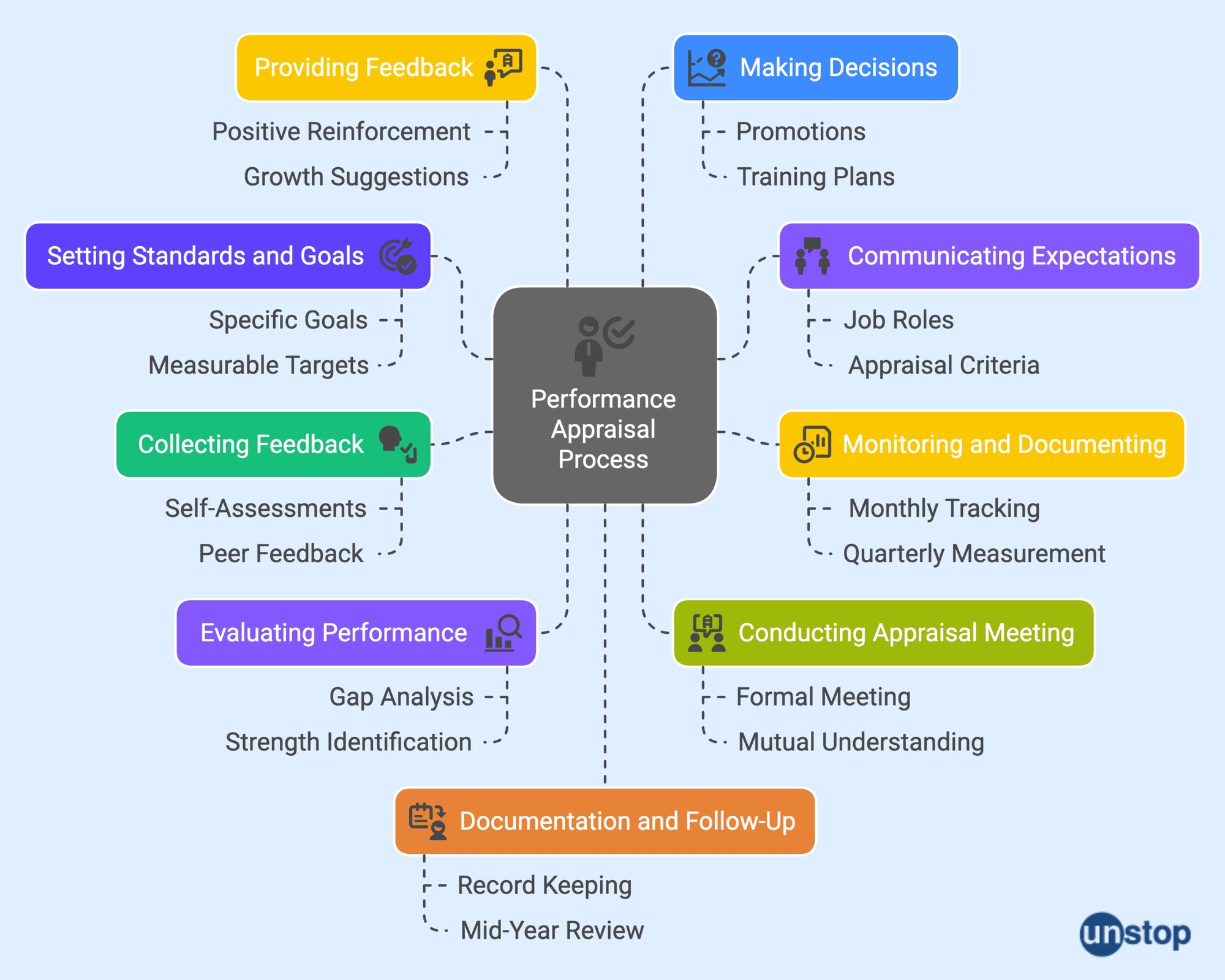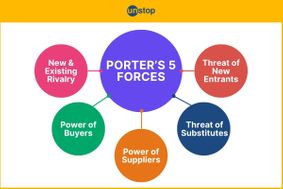- What is Human Resource Management (HRM)?
- Importance of HRM in an Organization
- What are the key Objectives of HRM?
- What are the main functions of HRM?
- Scope of HRM in an Organization
- Role Of HRM in an Organization
- Technology Integration & Future Trends in HRM
- Career Paths In Human Resource Management
- Conclusion
- Frequently Asked Questions (FAQs)
- Simulation Training: Understanding the Concept
- Evolution of Training Methodologies
- Benefits of Simulation Training
- Implementing Simulation Training in Organizations
- Future Simulation Training Trends
- Summing Up
- Frequently Asked Questions
- What do you mean by Performance Appraisal?
- Purpose & Objective of Performance Appraisal
- Types of Performance Appraisal
- Methods of Performance Appraisal: Benefits & Drawbacks
- Understanding the Working of Performance Appraisal
- Benefits of Performance Appraisal with Examples
- Criticisms & Limitations Of Performance Appraisal
- Conclusion
- Frequently Asked Questions (FAQ)
- Job Analysis: Definition & Importance
- Job Analysis: Key Components
- Identifying The Right Moment For Job Analysis
- Navigating Job Analysis Process
- Distinguishing Job Analysis & Evaluation
- Using The Findings Of Job Analysis
- Conclusion
- Frequently Asked Questions (FAQs)
- Deciphering Training & Development
- Difference Between Training, Development & Learning
- Significance Of Training & Development In HRM
- Benefits Of Training & Development For Organizations
- Types & Methods Of Employee Training
- Building Blocks Of Training Programs
- Trends & Innovation In Employee Training
- Strategic Integration With Talent Management
- Addressing Challenges In Training & Development
- Frequently Asked Questions (FAQs)
- Understanding Strategic Human Resource Management
- Scope Of Strategic Human Resource Management
- Creating A Strategic HR Plan In 7 Steps
- Different Approaches To Strategic Human Resource Management
- Importance Of Strategic Human Resource Management
- Characteristics Of Strategic Human Resource Management
- Frequently Asked Questions (FAQs)
- What is Selection Procedure in HRM?
- Stages Of Selection Procedure In HRM
- Making Informed Decisions With Job Offers
- Onboarding Strategies For New Hires
- Best Practices In Selection Procedure
- Conclusion
- Frequently Asked Questions (FAQs)
- Definition Of Human Resource Planning
- Understanding The Essence Of Human Resource Planning
- Key Objectives & Importance Of Human Resource Planning
- Strategic Alignment Of Human Resource Planning
- Core Steps Involved In Human Resource Planning Process
- Analyzing Labor Market Dynamics
- Tools & Techniques For Human Resource Planning
- Common Challenges & Solutions In Human Resource Planning
- Future Trends Influencing Human Resource Planning
- Measuring Success & Progress In Human Resource Planning
- Frequently Asked Questions (FAQs)
- Concept & Purpose Of Job Evaluation
- Overview Of Job Evaluation Methods
- Importance Of Implementing A Job Evaluation System
- Steps To Conduct A Thorough Job Evaluation
- Selecting Appropriate Method For Job Evaluation
- Establishing Job Evaluation Committee
- Advantages & Limitations Of Job Evaluation Techniques
- Maintaining & Updating Job Evaluation Process
- Frequently Asked Questions (FAQs)
- What is Training Needs Analysis?
- Purpose of Training Needs Analysis
- What are the Types of Training Needs Analysis?
- 7 Key Steps to Conduct Training Needs Analysis
- Methods of Data Collection for TNA
- What are the Benefits of Training Needs Analysis?
- Conclusion
- Frequently Asked Questions (FAQ)
- Types of Training Methods
- On-the-Job Training Methods (Learning by Doing)
- Off-the-Job Training Methods (Structured Learning)
- Microlearning & Mobile Learning
- Peer-to-Peer & Self-Directed Learning
- Choosing The Right Method
- Traditional Vs Modern Training Techniques
- Evaluating The Different Types Of Training Methods
- The Future of Training
- Conclusion
- Frequently Asked Questions (FAQs)
- What is Job Design in HRM?
- Methods of Job Design: Key Strategies
- The Impact of Taylorism on Job Design
- Hackman and Oldham Model or the Job Characteristics Model
- Socio-Technical Systems and Job Design
- The Job Design Process: Best Practices
- Things to Keep in Mind for an Effective Job Design Process
- Conclusion
- Frequently Asked Questions (FAQs)
- What is Training?
- What is Development?
- Core Differences Between Training and Development
- Similarities Between Training and Development
- Why This Difference Matters: Strategic Implications
- Importance of Training and Development
- Common Pitfalls of Confusing Training and Development
- Integrating Training and Development for Holistic Growth
- Frequently Asked Questions (FAQs)
- Key Challenges in Human Resource Management
- Addressing HRM Challenges Globally
- Legal and Regulatory Compliance in HRM
- Enhancing Productivity in HRM
- HRM Challenges in India
- Strategic Role of HR Leaders
- Technological Advancements in HRM
- Diversity and Inclusion in the Workplace
- Conclusion
- Frequently Asked Questions
- What do You Mean by Sources of Recruitment?
- Internal Sources of Recruitment
- Advantages & Disadvantages of Internal Sources of Recruitment
- External Sources of Recruitment
- Advantages & Disadvantages of External Sources of Recruitment
- Key Differences Between Internal & External Sources of Recruitment
- Innovative Recruitment Channels in the Digital Era
- Conclusion
- Frequently Asked Questions
- Want to Source Right & Optimize Your Recruitment Process?
- What is Human Capital?
- Human Capital Theory Explained
- Human Capital and Economic Growth
- Measuring Human Capital
- Human Capital Formation
- Human Capital Management Strategies
- Role of Education in Human Capital Formation
- Critiques of Human Capital Theories
- Future of Human Capital in Business
- Conclusion
- Frequently Asked Questions
- What is Wage?
- Types of Wages
- What is Minimum Wage?
- What is EPF Wage?
- What is the Differential Wage Rate?
- What is Real Wage?
- What is a Living Wage?
- Theories of Wages
- Factors That Affect Wages
- How Are Wages Calculated? (Formula to Calculate Wage)
- Key Differences Between Wages Vs. Salary
- Conclusion
- Frequently Asked Questions (FAQs)
- Definition Of Training Evaluation
- Understanding Training Evaluation Models
- Different Types Of Training Evaluation Methods
- Importance & Benefits Of Training Evaluation
- Formative Vs Summative Training Evaluation
- Creating An Effective Training Evaluation In Simple Steps
- Strategies For Employee Training Evaluation
- CIPP & Kaufman's Models In Training Evaluation
- Measuring & Analyzing Training Outcomes
- Best Practices For Conducting Training Evaluation
- Frequently Asked Questions (FAQs)
- What is Wage and Salary Administration in HRM?
- Importance of Wage and Salary Administration
- Objectives Of Wage & Salary Administration
- Principles Of Wage & Salary Administration
- Factors Influencing Wage & Salary Levels
- Frequently Asked Questions (FAQ)
- Meaning Of HR Professional
- Role Of An HR Professional
- Essential Skills Of Successful HR Professionals
- Effective Communication In HR Professionals
- Decision-Making & Problem-Solving In HR Professionals
- Frequently Asked Questions (FAQs)
- Definition & Evolution Of HRMS
- Understanding The Core Functionalities Of HRMS
- Key Features & Components Of HRMS
- Benefits & Importance Of Implementing HRMS
- Security Measures & Data Protection In HRMS
- Role Of Artificial Intelligence In HRMS
- Choosing The Right HRMS For Your Organization
- Frequently Asked Questions (FAQs)
- Definition Of Job Characteristics Model
- Hackman And Oldham Job Characteristics Model
- Five Core Job Characteristics Model Explained
- Psychological States & Work Outcomes in JCM
- Autonomy & Role In Job Satisfaction
- Task Significance
- Impact Of Feedback On Job Performance
- Factors Influencing The JCM's Effectiveness
- Practical Implications For SEO Content Writing
- Frequently Asked Questions (FAQs)
- Definition Of Executive Compensation
- Basics Of Executive Compensation
- Key Components Of Executive Compensation
- Purpose Of Compensation Packages
- Role Of Executive Compensation
- Types & Structures Of Executive Compensation Plan
- Short, Medium & Long-Term Compensation
- Trends & Regulations
- Best Practices For Executive Compensation
- Corporate Strategy & Governance
- Controversies & Criticisms
- Frequently Asked Questions (FAQs)
- Defining Employee Relations
- Importance Of Employee Relations Management
- Strategies For Effective Employee Relations
- Role Of An Employee Relations Specialist
- Resolving Workplace Disputes & Conflicts
- Addressing Wage Concerns & Policy Clarification
- Legal Compliance & Employee Relations Management
- Frequently Asked Questions (FAQs)
- What is International Human Resource Management?
- Objectives of International HRM
- Functions of International HRM
- Models of International HRM
- Strategies For Effective IHRM Implementation
- Key Differences Between IHRM and Domestic HRM
- Challenges in International HRM
- Frequently Asked Questions (FAQs)
- Importance Of Executive Development In HRM
- Methods Of Executive Development
- Objectives Of Executive Development
- Importance & Benefits Of Individualized Development Programs
- Frequently Asked Questions (FAQs)
- Defining Personnel Management & Objectives
- Key Functions Of Personnel Management
- Roles & Duties Of A Personnel Manager
- Personnel Management Vs. HRM
- Approaches & Policies In Personnel Management
- Manpower Planning, Recruitment & Selection Processes
- Training & Development Within Personnel Management
- Analysing Current Trends In Personnel Management
- Frequently Asked Questions (FAQs)
- What do you mean by Job Evaluation?
- What Are the Importance of Job Evaluation Methods?
- Best 7 Job Evaluation Methods in HRM
- Role Of Market Pricing In Job Evaluation
- Advantages & Disadvantages Of Job Evaluation Methods
- Career Progression, Legal Considerations & Compliance
- Best Practices For Job Evaluations
- Conclusion
- Frequently Asked Questions (FAQs)
- What is Personnel Management (PM)?
- What is Human Resource Management (HRM)?
- Similarities Between Personnel Management & HR Management
- Elaboration on Key Evolutionary Shifts
- Emerging Trends in Modern Human Resource Management
- Frequently Asked Questions (FAQs)
- Introduction to Kirkpatrick Model
- Origin & Evolution of the Kirkpatrick Model
- Importance of the Kirkpatrick Model
- Implementing the Kirkpatrick Model Training Evaluation
- Measuring Reaction: The First Level of Evaluation
- Assessing Learning: The Second Level Explained
- Evaluating Behavior Change: The Third Level of Impact
- Analyzing Results: The Fourth Level of Training Effectiveness
- Balancing Limitations in the Kirkpatrick Model
- Final Remarks
- Frequently Asked Questions (FAQs)
- Exploring The Concept Of Salary
- Key Differences Between Wages And Salary
- Types Of Wages & Their Impact on Earnings
- Varieties Of Salary Structures
- Advantages Of Earning Wages
- Benefits Of Receiving A Salary
- Legal Distinctions In Wage & Salary
- Overtime Compensation In Wage & Salary
- Frequently Asked Questions (FAQs)
- Fringe Benefits Meaning & Objectives
- Examples & Types Of Fringe Benefits
- Necessity Of Fringe Benefits By Law
- Tax Implications For Various Fringe Benefits
- Valuing & Calculating Fringe Benefits
- Role Of Cafeteria Plans In Fringe Benefits
- Impact Of Fringe Benefits On Employees
- Business Impact Of Fringe Benefits
- Considerations In Offering Fringe Benefits
- Conclusion
- Frequently Asked Questions (FAQs)
- What Is HR Compliance & Importance
- Key Elements Of An HR Compliance Checklist
- Managing HR Compliance In The Workplace
- Conducting An Effective HR Compliance Audit
- Overcoming Challenges In HR Compliance
- Automation For Streamlined HR Compliance
- Best Practices For Enforcing HR Compliance
- Long-term Data Governance In HR Compliance
- Frequently Asked Questions (FAQs)
- What is Recruitment Process In HRM?
- 5 Essential Stages of Recruitment & Selection Process
- Identifying Vacancies & Crafting Effective Job Descriptions
- Job Portals, Social Media & Technology in Recruitment
- Internal Vs External Sources of Recruitment
- Strategies for effective Recruitment in HRM
- Psychometric Tests used in Recruitment
- Conclusion
- Frequently Asked Questions (FAQs)
What is Performance Appraisal? Meaning, Types, Methods, and Benefits

Imagine you've been working at a company for several years. How do you reflect on the progress you've made? More importantly, is there a system in place to help you assess your performance against clear criteria? Does your organization have tools to ensure accountability and keep everyone aligned with shared goals?
This article explores the core elements of the performance appraisal process, its purpose, how to conduct effective performance reviews, and how to build a strong performance management system.
What do you mean by Performance Appraisal?
Performance appraisal is a formal, systematic process in a company related to the work of an employee in which an employee’s job performance is evaluated against established criteria by their manager or supervisor.
An effective performance appraisal helps managers make informed decisions about promotions, compensation, training needs, and career development. It also allows organizations to identify skill gaps and offer targeted training and growth opportunities.
Purpose & Objective of Performance Appraisal
The purpose and objective of a performance appraisal are to evaluate how well an employee has achieved specific goals, fulfilled responsibilities, enhanced skills and demonstrated workplace behaviors over a set period of time. Let’s get into the details of the key purposes of performance appraisal:
Assessing Employee Performance
The first and most important purpose of performance appraisal is to gauge how well employees are meeting organizational goals and expectations. By conducting regular assessments, employers can gain insight into individual performance levels, identify strengths, and pinpoint areas for development. This process enables managers and supervisors to provide constructive feedback that helps employees grow professionally.
Identifying Training Needs of Employees
Performance appraisals also serve as a means to identify training needs within the organization. By evaluating employee performance, managers can determine where additional training or skill development may be necessary for an employee. This allows organizations to invest in their employees' professional growth, helping them acquire the knowledge and skills needed to excel in their roles.
Recognizing High Performers
Another objective of performance appraisals is to recognize high-performing employees. These evaluations provide an opportunity for managers to acknowledge exceptional work and reward those who consistently exceed expectations. Recognizing high performers not only boosts morale but also encourages others to strive for excellence.
Addressing Performance Issues
On the flip side, performance appraisals also help address any performance issues that may arise within the workforce. Through open communication during appraisal discussions, managers can address concerns or challenges faced by employees and work together towards finding solutions.
Promotions & Compensation Decisions
Performance appraisals guide key decisions like promotions, transfers, and compensation by offering an objective view of employee performance. They help ensure career growth and rewards are based on merit, not favoritism.
Types of Performance Appraisal
Performance appraisal can be categorized into six main types based on the methods used to evaluate employees. Let us study each of the types:
1. Managerial Appraisal
In managerial appraisal, supervisors or managers directly evaluate an employee's performance based on their work, achievements, and behavior. It's the most traditional and widely used form of appraisal.
2. 360-Degree Feedback Appraisal
In a 360-degree feedback appraisal, feedback regarding the employees is gathered from various sources, such as supervisors, peers, subordinates, and clients, offering a well-rounded evaluation from multiple perspectives.
3. Self-Appraisal
In self-appraisal, employees evaluate their own performance, allowing for self-reflection and personal development. This type of performance appraisal encourages employees to identify their own strengths and areas for improvement.
4. Peer Review Appraisal
In peer review appraisal, colleagues assess each other's performance, providing feedback based on interactions and teamwork. This is effective in team-based environments.
5. Team-Based Appraisal
In team-based appraisal, the entire group's performance is evaluated rather than focusing on individuals. This type of appraisal promotes accountability and collective responsibility.
6. Customer/Client Appraisal
In customer or client appraisal, feedback from external clients or customers is used to evaluate employees, especially in customer-facing roles, ensuring that an employee's service quality and client interaction are gauged depending on the feedback sources and workplace dynamics.
Methods of Performance Appraisal: Benefits & Drawbacks
Let us now explore nine (9) common methods of performance appraisal, detailing their advantages, disadvantages, and how they work:
|
Method |
Description |
Advantages |
Disadvantages |
|
1. Rating Scale Method |
Employees are rated on a numeric scale (e.g., 1–5) based on traits like punctuality, teamwork, and job knowledge. |
|
|
|
2. 720-Degree Feedback |
Feedback is collected from colleagues and external sources (clients, stakeholders). |
|
|
|
3. Management by Objectives (MBO) |
Managers and employees set measurable goals; performance is evaluated based on results. |
|
|
|
4. Behaviorally Anchored Rating Scales (BARS) |
Combines rating scales with specific behavior examples for each level. |
|
|
|
5. Critical Incident Method |
Focuses on key positive/negative events that impact performance. |
|
|
|
6. Checklist Method |
Uses a yes/no checklist of traits, behaviors, or skills for quick assessment. |
|
|
|
7. Forced Distribution Method |
Employees are ranked into fixed performance categories (e.g., top 20%, bottom 10%). |
|
|
|
8. Essay or Narrative Method |
Managers write detailed qualitative appraisals covering strengths, weaknesses, and achievements. |
|
|
|
9. Human Resource Accounting Method |
Measures an employee’s financial value and contribution to the organization. |
|
|
Understanding the Working of Performance Appraisal
Let’s take a closer look at how performance appraisal actually works with examples:

Setting Performance Standards and Goals
What happens: The manager and employee agree on specific, measurable, and time-bound goals at the beginning of the appraisal cycle.
Why it's important: Clear goals provide a benchmark for evaluating performance later.
Example: A salesperson is given a quarterly target to close 15 new deals and maintain a 90% client satisfaction rate.
Communicating Expectations
What happens: The organization communicates job roles, performance expectations, and appraisal criteria to employees.
Why it's important: Ensures both parties are on the same page and reduces confusion.
Example: A team leader explains that punctuality, collaboration, and output quality will be part of the review.
Monitoring and Documenting Performance
What happens: Throughout the appraisal period (monthly, quarterly, or annually), the employee’s performance is observed, measured, and documented.
Why it's important: Ongoing tracking ensures a fair and accurate assessment.
Example: A project manager tracks deadlines met, client feedback, and quality of work done over six months.
Collecting Feedback and Data
What happens: Managers may gather feedback from various sources—self-assessments, peers, subordinates, or clients (360-degree feedback).
Why it's important: Provides a holistic view of employee performance and behavior.
Example: A software engineer receives input from both their team and a project client.
Evaluating Performance
What happens: The manager compares the employee’s actual performance against the set standards.
Why it's important: Helps identify gaps, strengths, and areas of improvement.
Example: A teacher’s performance is evaluated based on student feedback, classroom engagement, and exam results.
Conducting the Appraisal Meeting
What happens: A formal meeting is held between the employee and the manager to discuss performance results.
Why it's important: Encourages open communication and mutual understanding.
Example: An HR manager sits with an employee to go over strengths, weaknesses, and future goals.
Providing Feedback
What happens: Constructive feedback is shared, both positive reinforcement and suggestions for growth.
Why it's important: Motivates employees and directs their development.
Example: An employee is praised for leadership skills and advised to improve time management.
Making Decisions
What happens: Based on the appraisal, decisions are made regarding promotions, training, bonuses, or improvement plans.
Why it's important: Links performance directly to career and organizational growth.
Example: An underperforming employee is put on a Performance Improvement Plan (PIP), while a high performer is promoted.
Documentation and Follow-Up
What happens: The results and decisions are recorded for transparency and future reference. Follow-up meetings are scheduled to track progress.
Why it's important: Keeps performance records and ensures continuous development.
Example: The appraisal report is stored in the employee’s file, and a mid-year review is scheduled.
Benefits of Performance Appraisal with Examples
Let us now consider the benefits of prerfimrance appraisal with examples for better clarity:
Improves Employee Performance
Benefit: Appraisals provide constructive feedback that helps employees enhance their work quality.
Example: A graphic designer learns they need to improve time management. With guidance, they start delivering projects ahead of deadlines.
Supports Career Development
Benefit: Performance reviews help identify growth areas and training needs, encouraging skill development.
Example: A software developer shows strong leadership potential, so they’re recommended for a team leader training program.
Informs HR Decisions
Benefit: Appraisal data supports fair decisions on promotions, transfers, or salary adjustments.
Example: An employee with high scores across multiple reviews is promoted to a senior role with a salary increase.
Boosts Communication
Benefit: Regular feedback sessions open up two-way communication between employees and managers.
Example: A sales executive discusses workload challenges during their review, and their manager adjusts targets to support them.
Recognizes and Rewards Efforts
Benefit: Appraisals help identify and reward high performers, boosting morale and motivation.
Example: A customer service agent is praised for excellent feedback from clients and receives a performance bonus.
Aligns Individual Goals with Organizational Goals
Benefit: Appraisals ensure that employee objectives support broader business goals.
Example: A marketing specialist’s Key Performance Indexes (KPIs) are adjusted to focus more on lead generation, aligning with the company’s growth strategy.
Identifies Skill Gaps
Benefit: Performance reviews reveal areas where employees need improvement or training.
Example: An appraisal shows a finance analyst lacks proficiency in Excel. They are enrolled in an advanced spreadsheet course.
Criticisms & Limitations Of Performance Appraisal
Let us now see some of the criticisms and limitations of the performance appraisal system:
Subjectivity
One common criticism of performance appraisal systems is their subjective nature. Evaluating an employee's performance can be influenced by personal biases, leading to unfair assessments. This subjectivity can undermine the credibility and effectiveness of the entire appraisal process.
Time-Consuming
Many organizations find that conducting performance appraisals is a time-consuming task. Managers often have to gather and review extensive amounts of data before providing feedback to employees. This process can be overwhelming and may result in rushed evaluations that do not accurately reflect an employee's true performance.
Lack Of Accuracy
Furthermore, some critics argue that traditional appraisal systems lack accuracy. These systems typically rely on annual or semi-annual reviews, which may not capture an employee's day-to-day contributions adequately. The infrequency of these evaluations can lead to a distorted understanding of an individual's overall performance.
Rater Bias
Rater bias poses another significant limitation in performance appraisal systems. Evaluators may exhibit various biases, such as leniency or strictness when assessing employees' performance. These biases can skew the results and hinder the fairness and objectivity of the appraisal process.
Lack of proper Training for Evaluators
Inadequate training for evaluators can compromise the reliability and validity of performance appraisals. Without proper training on assessing employees effectively, evaluators may struggle to provide accurate feedback or make informed decisions regarding promotions or rewards.
Limited Developmental Focus
Another limitation lies in the limited focus on developmental aspects within traditional appraisal systems. While these systems often emphasize evaluating past performance, they may neglect opportunities for growth and improvement. Failing to address development needs can hinder employees' professional advancement and limit their potential contribution to the organization.
Conclusion
In conclusion, performance appraisals play a vital role in enhancing employee development and organizational success by providing structured feedback, setting clear goals, and recognizing achievements. When done effectively, they foster open communication, align individual contributions with broader company objectives, and promote continuous improvement.
Ultimately, performance appraisals help drive employee motivation, guide career development and improve overall productivity in the workplace.
Time For A Short Quiz!
Frequently Asked Questions (FAQ)
1. What is the purpose of performance appraisals?
Performance appraisals serve the purpose of evaluating an employee's job performance. It provides feedback about the strengths and areas for improvement for the employees. They help identify training needs, set goals, make promotion decisions, and enhance overall organizational performance.
2. What are some common methods used in performance appraisals?
Common methods used in performance appraisals include 360-degree feedback, behaviorally anchored rating scales (BARS), management by objectives (MBO), and peer assessment. These methods provide different perspectives on an employee's performance, allowing for a comprehensive evaluation.
3. How does 360-degree feedback work in performance appraisals?
360-degree feedback involves collecting input from multiple sources, such as supervisors, peers, subordinates, and customers, to evaluate an employee's performance. This method provides an overall view of an individual's strengths and weaknesses by considering various perspectives within the organization.
4. What are the benefits of conducting regular performance appraisals?
Regular performance appraisals offer several benefits, including improved communication between managers and employees, increased employee motivation through goal-setting and recognition, identification of skill gaps for training purposes, fair evaluation criteria for promotions or rewards, and overall enhancement of organizational effectiveness.
5. Are there any limitations or criticisms associated with appraisal systems?
Yes, some limitations or criticisms of appraisal systems include potential biases in evaluations due to subjective judgment, lack of clarity regarding evaluation criteria leading to unfair assessments, time-consuming nature that may distract from day-to-day work activities, and instances where the focus shifts more towards administrative tasks rather than meaningful development discussions.
Suggested reads:
- What Is An Appraisal Cycle? Meaning, Importance And Stages
- Top 15 Performance Appraisal Tips (With Examples) for Career Growth
- 100+ Self Appraisal Comments For Your Upcoming Performance Review
- Future Of Performance Appraisals: Modern Practices And Their Benefits
- Fixing Appraisal Grudges: Addressing Unhappy Employees Post-Appraisal
Instinctively, I fall for nature, music, humor, reading, writing, listening, traveling, observing, learning, unlearning, friendship, exercise, etc., all these from the cradle to the grave- that's ME! It's my irrefutable belief in the uniqueness of all. I'll vehemently defend your right to be your best while I expect the same from you!
Login to continue reading
And access exclusive content, personalized recommendations, and career-boosting opportunities.
Subscribe
to our newsletter
















Comments
Add comment